A mini-fridge is one of the best ways to have convenient access to a cold beverage or a light snack on demand. If you live in a dorm room or work in an office or garage, they tend to feel like a necessity.
However, something that's plagued all refrigerators is noise output. Luckily, a number of quiet mini-fridges using compressors or thermo-electric cooling exist. Choosing an option boils down to your specific needs as well as where you intend to use the refrigerator.
Midea is a well established brand in the home appliance space. They were established in 1968, have been featured in the fortune 500 list, and have received 40 design awards for their products.
This model by Midea is a two-door style mini-fridge. Meaning it has separate sections for refrigerator and freezer. This particular mini-fridge features a separate fruit and vegetable drawer making it a true compact refrigerator.
The refrigerator compartment is capable of adjustable temperature ranges of 32 to 50 degrees F. The freezer compartment is capable of adjustable temperature ranges of -11.2 to 5 degrees F.
Midea doesn't offer much in the way of dB ratings. However they do note that they engineered a whisper-quiet compressor that's virtually undetectable when it cycles on and off. This makes it perfect for dorm rooms, offices, RVs, and other spaces that require quiet operation.
hOmeLabs is a well known appliance manufacturer. Just like all their appliances, they know and understand that appliances should be both functional as well as add to the aesthetics of the space. They accomplish this via design as well as utilizing neutral colors.
This mini-fridge is a tall style beverage cooler. It's rated for 120 standard size beer/soda cans or even several bottles of wine. With that said, all the chrome shelves are removable and adjustable.
Since it's designed to chill beverages, it's temperature is rated as low as 34 degrees F, which is the ideal temperature for beer and soda. hOmeLabs also notes that you should not store meat, veggies, fruits, or other fresh foods.
The compressor is powered by 120V/240W and is noted to be whisper quiet. This cooler also uses a small convection fan that allows for consistent air circulation.
This is a tall style mini-fridge that features 3.2 cubic feet of storage space. Combined with a can dispenser, it's best suited for beverages and a small load of groceries.
Unlike two door mini-fridges, tall style options have a smaller freezer that's best suited for making ice or storing a candy-bar rather than freezing food.
This mini-fridge is designed to work with your space. The door is reversible which makes opening and closing a breeze regardless of position. The glass shelf is also removable making cleaning easier and allows you to store taller items.
This fridge uses a compressor cooler which are normally quite loud in operation. However, due to Kuppet's engineering, the mini-fridge only outputs 40 dB of noise which is essentially whisper quiet in operation.
This model by Antarctic Star is a compact mini-fridge made specifically for beverages, in particular, wine. While you don't have to be a wine drinker to own it, you can enjoy the benefits of a temperature controlled environment made specifically to chill drinks.
Wine's number one enemy is heat. This mini-fridge allows you to store wine at optimal temperatures to allow for long-term aging. The working temperature is rated at 40 to 61 degrees F. This temperature is ideal for a number of beverages: soda, beer, wine, etc.
The mini-fridge itself features 18 standard red or white bottle capacity, which is also perfect for beer or soda. This horizontal storage is a space-efficient way to store your beverages.
In terms of noise output, Antartic Star notes it emits 38 dB of noise. This is due to the advanced cooling system. The internal three-dimensional air-cooling system ensures that each corner of the fridge maintains a constant temperature with only a +/- 1 degree C swing.
This mini-fridge by Cooluli is a portable, 10.3 lb, AC/DC powered cooler. It works based on thermo-electric cooling known as the Peltier effect.
Thermo-electric coolers perform best in small enclosures. They're also known for being near quiet in operation; This is due to having minimal moving parts.
This cooler is on the smaller side, being more so catered to beverages. It's capacity is 15 liter/18 cans. In terms of cooling, it's rated at 35-40 degrees F which is the ideal temperature for beverages.
It's important to place this cooler is an area that's not prone to temperature extremes. Ideally in a cool dry place where ambient temperature will have minimal effect on the cooling ability.
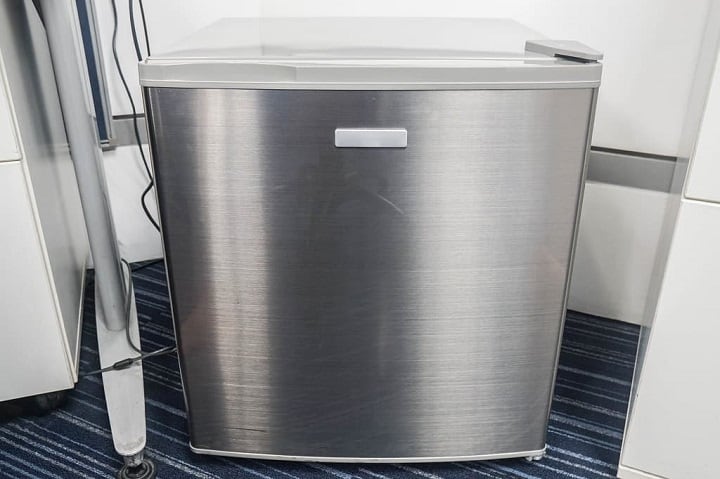
Nothing beats having access to a cold drink or snack on demand.
A mini fridge can also be the difference between a stark home office or a lackluster college dorm.
However, before making a purchasing decision, it's important to understand the differences between the types of mini fridges available as well as the factors that impact noise output.
Your choice will also depend on your personal needs. For instance, are you only looking to store beverages? Or do you also want to store food. Will it be in a Dorm? Office? Garage? All of these factors impact your decision.
When it comes to mini-fridges, there are typically two methods of cooling available: thermo-electric, and compressor based.
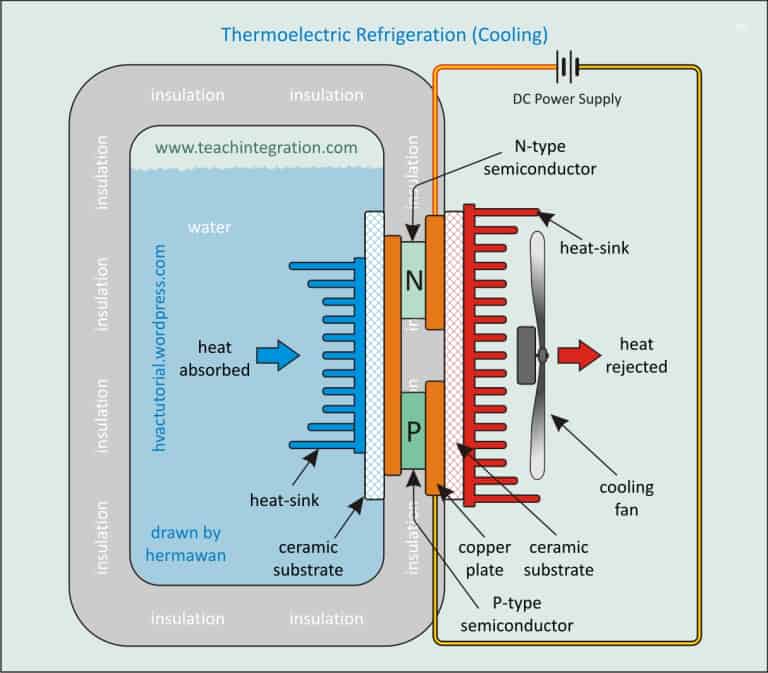
These types of coolers work based on the Peltier effect. This effect creates a difference in temperature by transferring heat energy between two electrical junctions.
A voltage is then applied across joined conductors in order to create an electrical current. The current then flows and heat is removed from one junction and as a result, cooling occurs. The heat is then deposited at the other junction.
The main goal of a Peltier effect is for cooling, hence applications in mini-fridges. However it's also used for heating and temperature control, for instance in dehumidifiers.
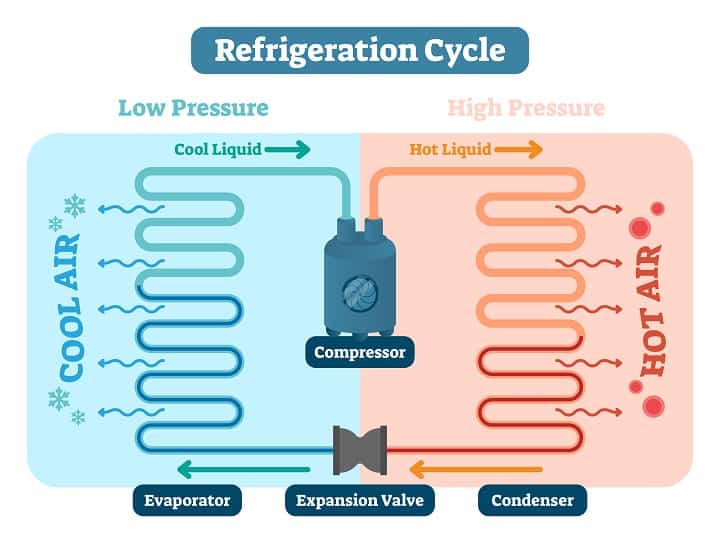
The refrigerator compressor is both a pump and a motor that moves refrigerant through a cooling system.
Temperature sensors will signal the compressor to operate when the temperature rises above a set point on a thermostat. Refrigerators aren't a closed system, meaning cold air will leak out and warm air can leak in resulting in temperature fluctuations.
As the compressor starts it will take in cold refrigerant gas in liquid form as it leaves the evaporator. The compressor then applies pressure to the gas, causing it to compress. When the gas in compressed, it causes its temperature to increase.
The now hot, compressed refrigerant gas is pushed out of the compressor and into condenser coils on the back of the refrigerator. The coils work to dissipate heat into the air and the gas then changes back to liquid form.
The liquid refrigerant travels through the system until it reaches the expansion valve. This valve will force the liquid through a small hole. This hole creates a pressure imbalance that causes the refrigerant to boil over and vaporize/mist as it passes through. This mist then evaporates as it passes through the freezer coils (occurs at -27 degrees F).
The cold liquid gas travels through the coils and draws heat out of the surrounding air in the refrigerator. This concept works based on the second law of thermodynamics: heat moves from warmer objects to colder objects. In this scenario the cold object is the refrigerant, and the warm object is the air.
The coils then lead back to the compressor. This process of compression and evaporation will continue until the sensors indicate that the desired temperature has been reached.
The different types of mini-fridges are more so a descriptor for the size or shape of the fridge. As you might expect, size and shape are heavily influenced by cooling method.
For instance, it's rather hard to incorporate the moving parts and compressor system into a compact mini fridge.
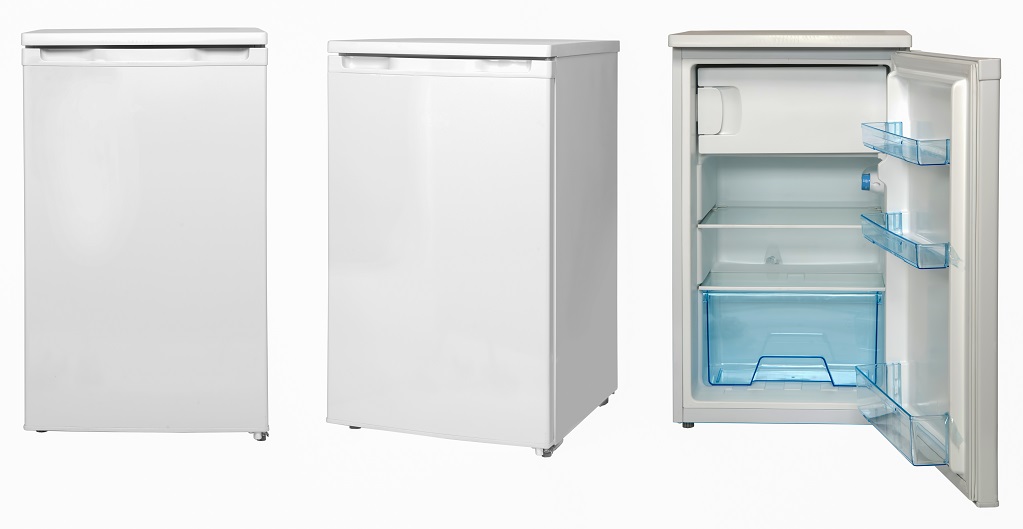
These types of mini-fridges are the most popular. They typically use a compressor based cooler. However the placement of the thermostat is usually in the refrigerator, rather than the freezer meaning temperature performance is usually better in the refrigerator section.
The compressor cooling system enables you to store both beverages and food. The separate freezer can also be used to make ice and store small things like a candy bar. As noted above, due to thermostat placement, it's best to avoid storing temperature sensitive items like ice cream because of temperature inaccuracies.
Note that tall models do exist without a freezer. These are usually labeled as "beverage coolers." As the name suggests, these refrigerators are only for beverages. They also tend to use thermo-electric cooling systems so placement of the mini-fridge is important.
These mini-fridges are similar to a regular refrigerator. As the name implies, it has two doors, one for the freezer and another for the refrigerator.
However, unlike the Tall models, the thermostat for two-door mini fridges is usually placed in the freezer. This means you can store temperature sensitive items without worrying whether they'll remain cold or not.
Like the Tall models, these also tend to use compressor cooling systems. As a result, you can safely store food and beverages as well as temperature sensitive items.
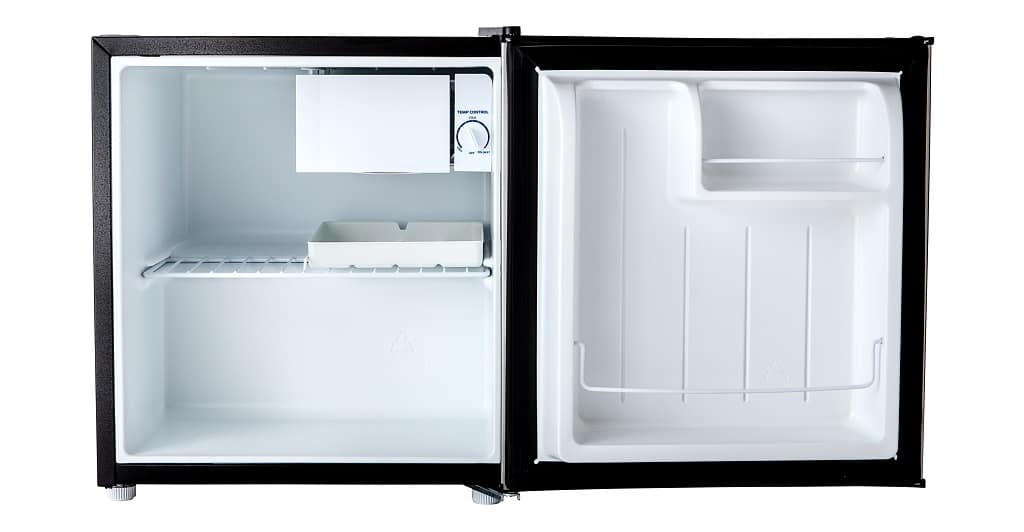
These are popular in college dorms as well as small living spaces. They are essentially bare bones mini-friges with enough space for a few items.
The thermostat is usually located in a very small freezer compartment that has enough space for an ice tray. If your goal is to store beverages, a cube mini-fridge will serve that purpose.
These types of mini-fridges can use both compressor-based coolers as well as thermo-electric. However, the compact nature usually results in more noise output in a compressor system.
As you can see, there are a number of factors to consider. Namely, determining what you're trying to store as well as the ambient temperature of the surrounding space.
While noise output is lower in thermo-electric coolers, being able to store food that's safe to consume is a priority. If this is your intention, opt for a compressor mini-fridge and consider ways to soundproof it instead (noise damping mats for example).

Snoringsource.com is a participant in the Amazon Services LLC Associates Program, an affiliate advertising program designed to provide a means for website owners to earn advertising fees by advertising and linking to amazon(.com, .co.uk, .ca etc) and any other website that may be affiliated with Amazon Service LLC Associates Program.